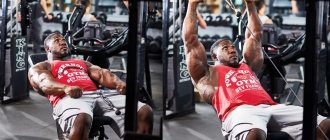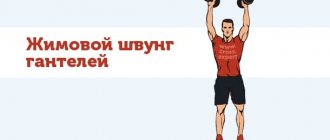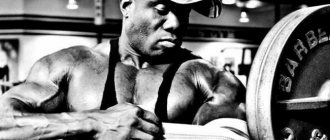The crossover crossover is an isolating exercise for the lower chest, which focuses on the lower chest. Those who want to have a beautiful “separation” of the pectoral muscle from the abs should do it at the end of the workout. Mixing in a crossover can be done both with the upper mount of the block system and with the lower one in order to engage the muscles at different angles. The movement is sometimes replaced by working in loops or with rubber, but for the classic “builder” cut of the pectoral muscle this movement is considered indispensable. The exercise is accessible to both beginners and professionals, and can be performed by both men and women.
Exercise technique
Initial position
It is important to determine where the handles are attached. Tall athletes can attach the pulley system to the uppermost clamp; with average height, it makes sense to lower it so that at the top point of the arm extension the shoulders do not lock in an uncomfortable position, and the athlete does not lose control of the core and chest muscles. If an athlete “throws up” during movement, he has chosen the wrong height of the clamp.
The handles used are curved or D-shaped. If there are no such handles in the gym, you can put on two round clamps and perform the movement with slight resistance by gripping the round clamps.
When taking the starting position, it is important not to injure yourself. First, grab one handle and bring it to the belt, then the second, after which you need to position your body in the center of the crossover so that the cables are tensioned equally. A stable stand “in scissors” or on two legs in an inclined position is allowed, this is not important.
Next, you should tighten your abs, tighten your buttocks and carefully move your arms up, in the direction of the cable fastenings.
Movement
The exercise involves bringing your arms together in front of you, at waist level. During work, you should consciously tense your chest muscles and not relax them for as long as possible, spreading your arms to the sides towards the block mechanisms.
All repetitions must be performed in the same manner so that the athlete does not change the trajectory of movement. A deepening of the back tilt is not allowed. It is often written that it should be strictly 45 degrees, but this is not so, the depth of the inclination is determined by the anatomical features of the athlete, and cannot be deeper than 45 degrees. A straight vertical stand is also not allowed. Otherwise, options are possible that will allow the athlete to work out the muscles more efficiently.
Bringing hands together in crossover
Attention
There are technical issues that are best avoided:
- Cheating with the body . You are not in Plush Beard's video, avoid swings, as they can injure the shoulder joints, even if the athlete does not feel pain or discomfort during the swing;
- Active hand pushes . Bodybuilding differs from weightlifting in that it loves controlled exercises. By pushing the weight we can lift more, but the goal of the movement is not to set a gym record on the cable machines.
- “Running” around the perimeter with your feet . It is worth standing up once so that the body position is strong, and not changing it, since “jogging” can cause a loss of shoulder stability and cause injury;
- Head nods . It’s unpleasant when your neck gets jammed during exercise. And it’s even more unpleasant when this “wonderful” feeling is accompanied by a shoulder injury. Therefore, excessive tension in the trapezius and nodding should be avoided. If you need to nod your head at all costs, the weight is chosen incorrectly, it is too heavy. Again, the weight must be selected so that there is no need to make additional and unnecessary movements of the body and head.
- "Disruption" at the start . Jerking with your arms can cause injury to both the shoulder and elbow joints;
- Rigidly “inserted” elbows at the start of the movement . This can cause hyperextension of the elbow ligaments and cause injury;
- Constantly sticking the same leg forward can lead to imbalances in the hip joint.
Crossover chest exercises
Biomechanically, all chest exercises are divided into:
- Bringing your arms together in front of you while standing, lying down, bending over, or on your knees;
- Forward presses while standing with your back to the handle mount
The latter option is often used in functional training, when the goal is to balance the work of the core muscles of an athlete who has scoliosis or poor posture. “People” usually divide exercises according to the level of attachment of the handles.
Bodybuilders tend to overestimate the role of isolation exercises, while strength athletes tend to underestimate it. The first ones write that “a feeling of burning and stretching” of the muscle is a sure sign that the pecs will grow. The second reminds that the chest works best at the start of the bench press, and everything else is just auxiliary exercises.
Important : predominant training of some muscle bundles, angles of the body, “feeling the muscles” will not help to gain mass in the pectorals. If a person has a deficiency of muscle mass, his first exercise is a bench press or dumbbell bench press. Information in the crossover is the last exercise of the chest workout, the goal is to complete it with minimal weight. Elimination of pressing movements is possible only if the athlete has an injury that does not allow him to press.
Execution options
Horizontal hands in a crossover while lying on a bench
The exercise is reminiscent of the well-known dumbbell fly, but instead of dumbbells, you hold crossover handles in your hands. The cables are attached to the lower part of the fastening sector so that the athlete’s arms are not “twisted” when taking the starting position. The bench can be horizontal or inclined; this is of no fundamental importance. It is believed that the pecs work more on the incline bench, but this is subjective and depends on the body type.
The bench is located strictly in the center, the athlete lies down on it, the assistant places the handles at the level of the center of the chest. Further, the movement resembles a regular “fly” with dumbbells, the arms are directed to the sides and brought to the center at the level of the middle of the chest. There is no need to allow an unnaturally large amplitude to avoid dislocating the shoulder joint.
Oblique information
Actually, they resemble the version with a split leg, but you need to stand up straight and not put your feet in a split leg. The body leans forward, the arms are lowered down, the pectoral muscles are tensed, the work is done by contracting the chest.
Reduction of hands in a crossover from the lower block
This movement requires a little more work from the anterior deltoid. You need to perform the exercise by attaching the handles to the bottom of the crossover. Then the athlete takes a step forward and brings his arms to chest level. This is followed by mechanical reduction of the arms at the level of the middle of the chest. The pectoral muscles contract at the point of maximum tension.
Chest muscles. Bringing your hands together in a crossover.
Tips: information in the crossover through the upper blocks
1. When performing the exercise with straight arms, you risk damaging your elbow joints. If, returning to the starting position, you straighten your arms, the chest muscles are actively involved in the work and decrease. This indicates that the selected weight is too heavy.
2. Maintain a stationary torso position throughout the entire exercise. Leaning forward to help your whole body bring the handles together takes the pressure off your chest.
3. Bring the handles together in a wide arc at chest level. Imagine that you are hugging a large tree. In this case, the focus of the load is aimed exactly at the middle of the chest. If you bring your arms high (at head level), then the tip of the attack shifts to the upper chest and front delts. The lower you move your arms (below your chest) or the less your torso is tilted, the more the lower pectoralis major muscle contracts.
4. Holding your breath during the positive phase of the exercise (bringing your arms together in front of your chest) makes it easier to keep your body still and increases your strength.
5. Don't strain your back and keep your shoulders pulled back. Thus, you exclude from the work the serratus anterior muscle, which pulls the lower edge of the scapula forward and outward, which is only possible when the shoulder is pronated (rotating it inward, toward the chest around a vertical axis). Hence the conclusion: bringing the arms together in front of the chest, round (pronate) the shoulders.
Analysis of the exercise
Anatomy of exercise - which muscles work
The main target group is the lower bundle of the pectoral muscle. The muscles of the back and core work as stabilizers; the anterior deltoids, serratus muscles, and the pectoralis minor muscle help with movement.
pros
This is a completely isolation exercise. It does not allow the triceps to be involved in the work, which means it is suitable for those who bench press a lot and consider the bench press their priority. The movement allows you to work the pectoral muscles without putting much strain on the stabilizers and biceps, allows you to achieve a greater amplitude, and stretch the muscles so as to shorten them as much as possible. The exercise is varied enough to avoid increased stress on the elbows, shoulders, and biceps. It helps to work the entire length of the muscle and allows you not to exclude the lower pectoral bundle from the work.
Minuses:
- Not all halls are equipped with a crossover, and there is not always access to it. This is a popular car and can be constantly busy during rush hour;
- Movement cannot help build muscle if it is all you do. Basic exercises required in addition to crossover work
Preparing for the exercise
Typically, the crossover is not the first movement in a workout, and is not used as an exercise to pre-fatigue the chest muscles. The training begins from the base, and only at the end the athlete approaches the block simulator to work the lower chest.
This means that joint warm-up is not necessary; it is enough to perform a couple of approaches with light weight.
Proper execution
- The exercise is single-joint - the work is done only in the shoulder joint;
- Cheating and body swings are excluded;
- The elbows in the upper phase should not be raised towards the ears, they are in the plane of the shoulder;
- The muscles must be consciously tensed, as if “bringing” the weight to the desired position;
- You can’t throw your head back, look at the ceiling, you should relax your neck and look forward;
- You need to use a stable body position, preferably a scissors stance;
- Work occurs along an elliptical or arcuate path. You should not “throw your arms up” by bending them at the elbows;
- The reduction is carried out approximately at waist level;
- It can be assumed that the athlete uses a small weight, but it is impossible to use pushes and jerks along the trajectory, and relaxed arms when lowering the weight;
- You need to try to consciously exclude working with the trapezius muscles
Muscle contraction is performed by exhaling, exhaling with effort - the basic rule when performing strength exercises.
Errors
- “Different” movements, when the athlete bends his arms at the elbows in the first repetition, and changes the position of the body in the second, and carries the weight differently;
- Body swings that help with weight work;
- Throwing weights;
- Relaxed and rounded back;
- "Inserted" straight elbows
HANDS IN CROSSOVER! Kock technique!)
Benefits and disadvantages of bringing hands together in a block
- The first thing you should pay attention to is the minimal risk of injury.
- Secondly, this is a narrowly targeted load, that is, during work, the pectoral muscles receive the lion's share of the load, which makes bringing the arms together a highly effective exercise.
- Another advantage of bringing your arms together in a crossover is the creation of high-quality muscles. The appearance of the pectoral muscles becomes more symmetrical and more aesthetic from the information.
- During the exercise, there is no load on the spinal column and joints of the body, except for the shoulder ones, so it is suitable for both men and women, as well as minor athletes.
- Block exercises are excellent for working the central part of the pectoral muscles.
Motion Efficiency Tips
Most often, bodybuilders advise consciously contracting the pecs at the lowest point. This can be achieved through a little isometry, and this, in turn, by slightly turning the palms towards each other at the bottom point of the exercise.
You can achieve maximum isolation and completely eliminate cheating by kneeling. This version of the starting position will allow the athlete to completely eliminate body swings.
If you need to shift the emphasis to the upper chest, you need to bring your arms higher. This can be achieved both by changing the angle of inclination of the body and by changing the fastening.
If you work “crosswise”, placing one hand behind the other at the bottom of the amplitude, you can achieve a strong muscle contraction without changing the amplitude.
Inclusion in the program
This exercise can be the only one on the chest only if we are talking about training a woman with breast implants. All other athletes should perform the movement at the end of the workout, after basic and other isolation exercises.
Usually performed in 12-15 repetitions in 3-4 sets, and the warm-up does not count as work. The exercise is not performed with heavy weight, so the rest can be quite short, about a minute between sets.











